


Legananny, County Down
This famous megalith is the most recognisable in the north of Ireland. Its superb siting, on the lower slopes of Slieve Croob 4 miles south of Dromara, suggests that its builders had an eye for location: from it a panoramic view opens to the south with the entire sweep of the Mourne Mountains ranged across the horizon.
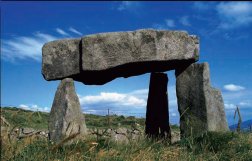 The tomb well displays the sculptural qualities that define a 'tripod dolmen', a term coined by James Ferguson in the nineteenth century to describe this and similar portal tombs, believing that it never had a covering cairn and was always intended to be seen as it stands now, 'a studied exhibition of a tour de force'. In fact, there is some evidence for a cairn, though it is unlikely to have ever completely covered the structure and Ferguson was probably correct in his assumption.
The tomb well displays the sculptural qualities that define a 'tripod dolmen', a term coined by James Ferguson in the nineteenth century to describe this and similar portal tombs, believing that it never had a covering cairn and was always intended to be seen as it stands now, 'a studied exhibition of a tour de force'. In fact, there is some evidence for a cairn, though it is unlikely to have ever completely covered the structure and Ferguson was probably correct in his assumption.
If proof were needed that Stone Age man built his monuments to instil awe as well as to endure, then it is surely to be found in the rugged granite geometry of Legananny, with its tall portal stones lifting the 10 1/2 feet-long tapered capstone clear against the sky. No recent excavations have been carried out, but old records refer to the discovery of urns here.
In the same townland is a fine Christianised standing stone of squarish appearance, 5 feet 9 inches high with a plain equalarmed cross inscribed on one side. The top of the stone is stepped or 'shouldered' in similar manner to the west portal stone of the dolmen.
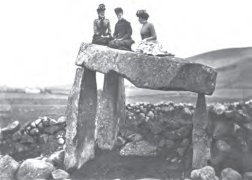 Dressed in finery more appropriate to a Victorian drawingroom than the stony slopes of Slieve Croob, the Countess Annesley and two Markham sisters pose on top of the famous Legananny dolmen during an excursion in the countryside. The photographer, probably Capt. H. Annesley, clearly had an eye for an unusual picture, and the ladies' evident agility in those long dresses calls for comment, but such frolics at an historic monument would be disapproved of today.
Dressed in finery more appropriate to a Victorian drawingroom than the stony slopes of Slieve Croob, the Countess Annesley and two Markham sisters pose on top of the famous Legananny dolmen during an excursion in the countryside. The photographer, probably Capt. H. Annesley, clearly had an eye for an unusual picture, and the ladies' evident agility in those long dresses calls for comment, but such frolics at an historic monument would be disapproved of today.
Proleek, County Louth
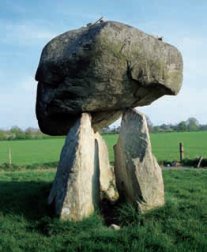 This accessible and much visited megalith stands in the spacious grounds of Ballymascanlon House hotel, 3 1/2 miles north-east of Dundalk and about 10 miles south of Newry. A classic 'tripod dolmen', it is known locally as 'the giant's load', since from the back it resembles a person stooped under a heavy burden, namely the great bulbous capstone estimated to weigh over 30 tons and delicately balanced on the pointed tops of 7-feet high portal stones and a slightly lower backstone. There is no formal chamber, and little evidence of a cairn. A whimsical custom still practised here requires a stone to be deftly tossed onto the top of the capstone without it rolling off the smooth convex surface; if accomplished, whoever threw it will wed before a year has elapsed.
This accessible and much visited megalith stands in the spacious grounds of Ballymascanlon House hotel, 3 1/2 miles north-east of Dundalk and about 10 miles south of Newry. A classic 'tripod dolmen', it is known locally as 'the giant's load', since from the back it resembles a person stooped under a heavy burden, namely the great bulbous capstone estimated to weigh over 30 tons and delicately balanced on the pointed tops of 7-feet high portal stones and a slightly lower backstone. There is no formal chamber, and little evidence of a cairn. A whimsical custom still practised here requires a stone to be deftly tossed onto the top of the capstone without it rolling off the smooth convex surface; if accomplished, whoever threw it will wed before a year has elapsed.
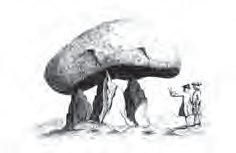 An early illustration of this monument appeared in Thomas Wright's Louthiana, published in 1748. Wright recognised the sepulchral purpose of these structures and dismissed as fantasy the notion that they were druid's altars. He records that 'the native Irish tell a strange story about it, relating how the whole was brought all at once from the neighbouring mountains by a giant called Parrah Borg M'Shagjean, and who they say was buried near this place'.
An early illustration of this monument appeared in Thomas Wright's Louthiana, published in 1748. Wright recognised the sepulchral purpose of these structures and dismissed as fantasy the notion that they were druid's altars. He records that 'the native Irish tell a strange story about it, relating how the whole was brought all at once from the neighbouring mountains by a giant called Parrah Borg M'Shagjean, and who they say was buried near this place'.
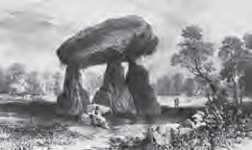 In contrast to Wright's instantly recognisable sketch, R. O'C Newenham's 1830 engraving in Picturesque Views of the Antiquities of Ireland presents a highly romanticised image of Proleek that is far removed from reality.
In contrast to Wright's instantly recognisable sketch, R. O'C Newenham's 1830 engraving in Picturesque Views of the Antiquities of Ireland presents a highly romanticised image of Proleek that is far removed from reality.
Click here to buy the Appletree Press book from Amazon.co.uk. For more information click on: Ireland's Ancient Stones - A Megalithic Heritage by Kenneth McNally, published by Appletree Press.
All Material © 1999-2008 irelandseye.com and contributors Privacy statement
